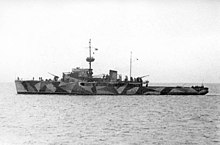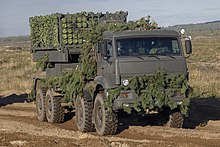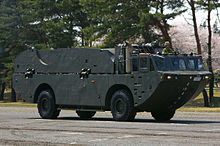Minelayer
This articleneeds additional citations forverification.(December 2007) |

| Part of a series on |
| War Outline |
|---|
 |
Aminelayeris anywarship,submarine,military aircraftorland vehicledeployingexplosive mines.SinceWorld War Ithe term "minelayer" refers specifically to a naval ship used for deployingnaval mines.[1]"Mine planting" was the term for installingcontrolled minesat predetermined positions in connection with coastal fortifications or harbor approaches that would be detonated by shore control when a ship was fixed as being within the mine's effective range.[2][3]
An army's special-purposecombat engineeringvehicles used to laylandminesare sometimes called "minelayers".
Etymology
[edit]Before World War I, mine ships were termedmine plantersgenerally. For example, in an address to theUnited States Navyships of Mine Squadron One atPortland,England,Admiral Simsused the term "mine layer" while the introduction speaks of the men assembled from the "mine planters".[4]During and after that war the term "mine planter" became particularly associated with defensive coastal fortifications. The term "minelayer" was applied to vessels deploying both defensive- and offensive mine barrages and large scale sea mining. "Minelayer" lasted well past the last common use of "mine planter" in the late 1940s.
Naval minelayers
[edit]


The most common use of the term "minelayer" is anaval shipused for deployingsea mines.Russian minelayerswere highly efficient sinking the Japanese battleshipsHatsuseandYashimain 1904 in theRusso-Japanese War.[5]In theGallipoli CampaignofWorld War I,mines laid by theOttoman Empire's Navy'sNusretsankHMSIrresistible,HMSOcean,and theFrench battleshipBouvet[6]in theDardanelleson 18 March 1915.[7]
In World War II, the British employed theAbdielminelayers both as minelayers and as transports to isolated garrisons, such asMaltaandTobruk.Their combination of high speed (up to 40 knots) and carrying capacity was highly valued. The French used the same concept for thecruiserPluton.
A naval minelayer can vary considerably in size, from coastal boats of several hundredtonnesindisplacementtodestroyer-like ships of several thousand tonnes displacement. Apart from their loads of sea mines, most would also carry other weapons for self-defense, with some armed well enough to carry out other combat operations besides minelaying, such as the World War II Romanian minelayerAmiral Murgescu,which was successfully employed as a convoy escort due to her armament (2 × 105 mm, 2 × 37 mm, 4 × 20 mm, 2 machine guns, 2 depth charge throwers).
Submarinescan also be minelayers. The first submarine to be designed as such was theRussian submarineKrab.USSArgonaut(SM-1)was another such minelaying submarine. Although there are no modern submarine minelayers, mines sized to be deployed from a submarine's torpedo tubes, such as theStonefish,allow any submarine to be a minelayer.
In modern times, few navies worldwide still possess minelaying vessels. TheUnited States Navy,for example, uses aircraft to lay sea mines instead. Mines themselves have evolved from purely passive to active; for example the USCAPTOR (enCAPsulated TORpedo)that sits as a mine until detecting a target, then launches a torpedo.
A few navies still have dedicated minelayers in commission, including those ofSouth Korea,Poland,SwedenandFinland;countries with long, shallow coastlines where sea mines are most effective. Other navies have plans to create improvised minelayers in times of war, for example by rolling sea-mines into the sea from the vehicle deck through the open aft doors of aRoll-on/roll-offferry. In 1984, theLibyan Navywas suspected of having mined theRed Seaa fewnautical milessouth of the Suez Canal using the Ro-Ro ferryGhat,other nations suspected of having similar wartime plans include Iran and North Korea.
Aerial minelaying
[edit]
Beginning inWorld War II,military aircraftwere used to deliver naval mines by dropping them, attached to aparachute.Germany, Britain and the United States made significant use of aerial minelaying.
Anew type of magnetic minedropped by a German aircraft in a campaign of mining the Thames Estuary in 1939 landed in a mudflat, where disposal experts determined how it worked, which allowed Britain to fashion appropriatemine countermeasures.
The BritishRoyal Air Forceminelaying operations werecodenamed"Gardening". As well as mining the North Sea and approaches to German ports, mines were laid in theDanube RivernearBelgrade,Yugoslavia,starting on 8 April 1944, toblock the shipments of petroleum productsfrom the refineries atPloiești,Romania.[8]
"Gardening" operations by the RAF were also sometimes used to assist incode breaking activitiesatBletchley Park.Mines would be laid, at Bletchley Park's request, in specific locations. Resulting German radio transmissions were then monitored for clues which could help deciphering messages encoded by the Germans usingEnigma machines.
In thePacific,the US dropped thousands of minesin Japanese home waters,contributing to that country's defeat.
Aerial mining was also used in theKoreanandVietnam Wars.In Vietnam, rivers and coastal waters were extensively mined with a modified bomb called adestructorthat proved very successful.
Landmine laying
[edit]


Some examples of minelaying vehicles:
- Shielder minelaying system
- Zemledeliye (minelaying system)
- GMZ family of minelayers, which the2S4 Tyulpanis based on, usingTM-62 series mines
- Minenwerfer Skorpion
- Type 94 Minelayer
- Istrice (M113 variant)
See also
[edit]- List of minelayer ship classes
- List of mine warfare vessels of the US Navy in the Second World War
- Mine Planter Service (U.S. Army)
- Minesweeper (ship)
- Submarine mines in United States harbor defense
Notes
[edit]- ^"minelayer".Definitions from Dictionary.com.Dictionary.com.Retrieved6 October2007.
- ^Chappel, Gordon."Submarine Mine Defense of San Francisco Bay".Historic California Posts — Forts Under the Sea.California State Military Museum.Retrieved23 May2013.
- ^"Principle Armament – Mine Field".FortMiles.org. Archived fromthe originalon 3 November 2013.Retrieved23 May2013.
- ^All Hands, ed. (1919)."Speech of Admiral W. S. Sims, U. S. Navy".The Northern Barrage, Mine Force, United States Atlantic Fleet, The North Sea, 1918.Annapolis, MD:Naval Institute Press.p. 108.
- ^Fitzsimons, B (ed.).The Illustrated Encyclopedia of 20th Century Weapons and Warfare.p. 104.
- ^Smith, Gordon."Naval War in Outline".World War 1 at Sea: French Navy.
- ^"Irresistible, Ocean and Bouvet Go Down, Hitting Mines in Strait".The New York Times.20 March 1915.
- ^Adkins, Paul (1997).Codeword Dictionary.Osceola, WI: Motorbooks International. p. 79.
References
[edit]- Hartcup, Guy (1970).The Challenge of War.New York: Taplinger Publishing Company.ISBN9780800814311.
- Hartmann, Gregory K. (1979).Weapons that Wait: Mine Warfare in the U.S. Navy.Annapolis, MD:Naval Institute Press.ISBN0-87021-753-4.
- Jurens, W. (2016). "Life in the Slow Lane: Some Thoughts on Minelayer and Netlayer Evolution".Warship International.LIII(1): 59–68.ISSN0043-0374.
External links
[edit]- Dewar, Alfred (1922)..Encyclopædia Britannica.Vol. 31 (12th ed.). pp. 949–995.
